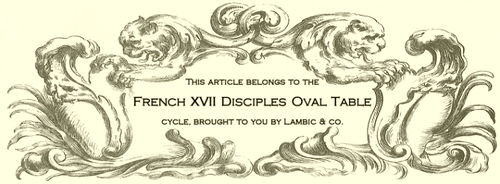French Royal Dolphin
“The Imperial Penguin isn't a fish, and the Royal Dolphin isn't a fish either: I'm off for a fish in the Ducal pond.”
– Oscar Wilde in "The Fisherman and His Soul"
“Notre magot prit, pour ce coup / Le nom d'un port pour un nom d'homme. / De telles gens il est beaucoup, / Qui prendroient Vaugirard pour Rome, / Et qui, caquetants au plus dru, / Parlent de thongs, et n'ont rien vu.”
– Jean de la Fontaine in "Le Singe et le Dauphin", original, non-subtitled version (collector's item)
The "Dauphin", or French Royal Dolphin, was a prominent member of the French high society. Raised in a dedicated Royal Dolphin Farm called the "Dauphiné", he used to occupy the Royal throne in case of minority of age of the Royal Heir. Such was the case of Louis XIV (not to be confounded with Louis "Rabane" Quatorze), who was only 5 years old when his predecessor, aka as "Number 13", died. The Royal Dolphin being a mammal, his presence out of his natural element wasn't a big problem. He only had to "sit" on the throne during the so-called "audiences".
The people and the Dolphin[edit | edit source]
The landlubbers[edit | edit source]
The good French people, also called "plebs" or "landlubbers", stood in awe before such magnificent and mysterious animal. The black market knew a lucrative but dangerous trade in Royal Dolphins' remains, including the bribing of Royal Palace's guards to be able to cut some bits off a freshly deceased Royal Dolphin.
The sailors[edit | edit source]
The French sailors, often called "marins" or "Pirates", were pretty hostile towards the chosen animal:
- the fishermen who thought dolphins were fish, weren't allowed to fish it;
- the fishermen who thought them to be mammals, weren't allowed to hunt it;
- the Pirates, except Jean Bart, weren't allowed to turn them into prow figures.
Mazarin's flunked money design[edit | edit source]
Heading the young Louis XIV's Regency as France's Prime Minister, Cardinal Jules R. Mazarin, a kicked-out Italian originally named "Giulio Raimondo Mazarino", made personally, all by himself, a design for a new "Louis d'or" (a "Golden Louie" in foreign manuals). This gold piece showed Mazarin's classical taste and his vision of the Royal Dolphin, but bounced off on Louis' more modern taste. The young King wasn't very pleased with the helmet nor with the way his nose was drawn, and also wondered why the new piece should have ear-like handles. Mazarin was too offended to answer that question, and withdrew his design. The drawing itself was found very recently, and this is probably the very first publication of it. You'll see that any text hasn't been added yet, but Mazarin didn't feel like finishing the job after the King's refusal. He tried to take his revenge on the French people through heavy taxes, but that experiment ended up in the so-called "Fronde Civil War". Luckily, no dolphins were harmed during that war.
The Royal Dolphin in literature[edit | edit source]
The famous French author Jean de la Fontaine (referred to as "John Well" in foreign manuals) dedicated a poem, called "Le Singe et le Dauphin" ("The Monkey and the Dolphin" in foreign manuals), to this wonderful animal. It is said that the monkey stood for the French clergy, but John Well never admitted that in public. Presumably, he had already enough troubles because of his revering a fancy colored single-horned but nonetheless invisible horse-like animal.
Royal Dolphin care[edit | edit source]
When not "holding audiences", the acting Royal Dolphin went into a specially designed aquarium. Versailles' Royal Dolphin Aquarium was a widely known touristical attraction, which helped the French Royal Family to "feed the little ones". The French people waited in long cues, ready to pay a substantial fee to be able to see the Royal Dolphin juggling to keep his little crown on his head while swimming. Once the Royal Heir was able to reign, the Royal Dolphin stayed in the aquarium till natural death took him away. Until that moment, he kept the little crown that put him on equal heighth with any Royal Prince, and after burial, it was put on his grave in the Royal Mausoleum. This led to confusion between historians, who were tempted to add the Dolphins to the Royal family tree.


